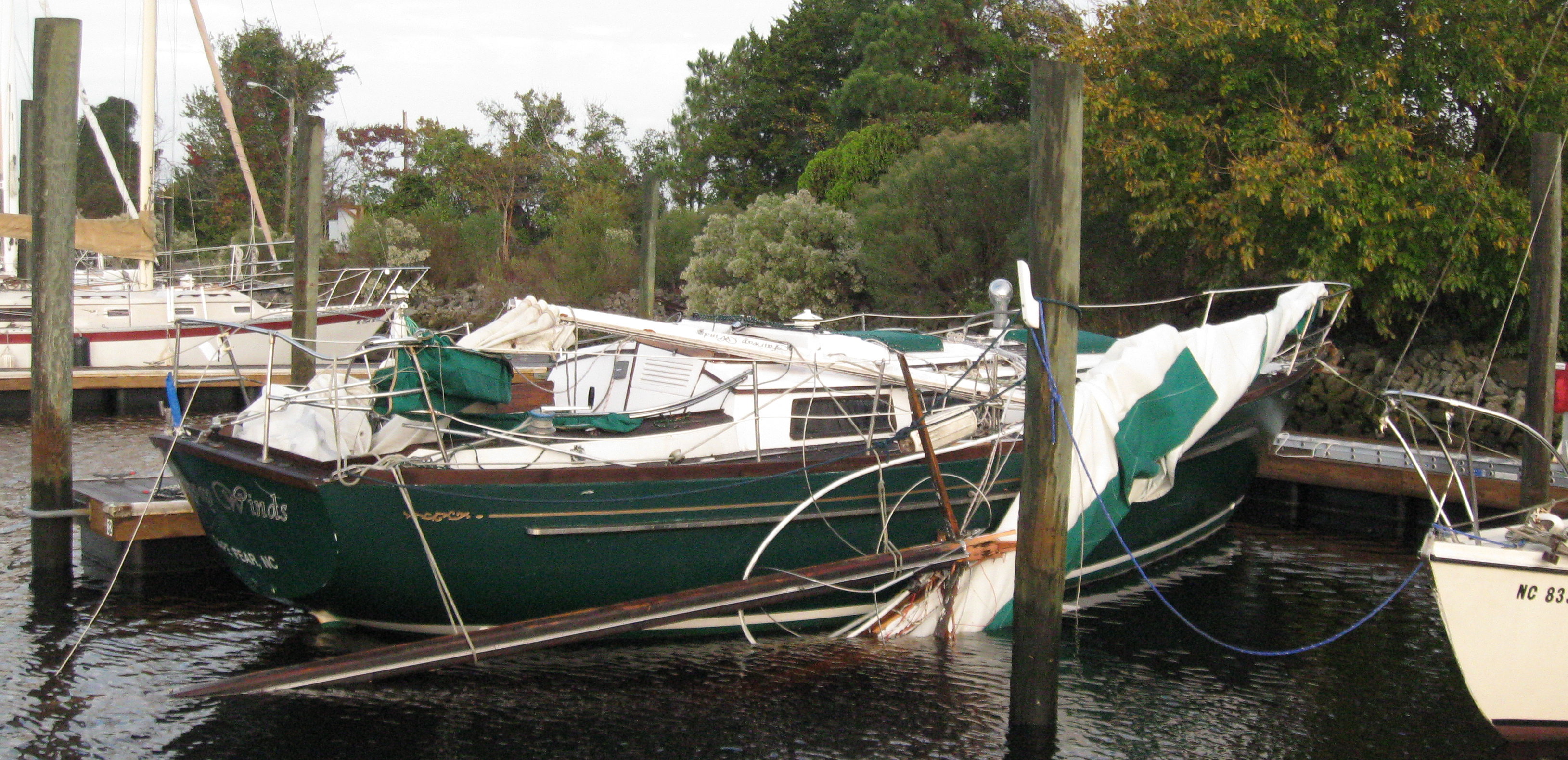By Capt. Wayne Canning, AMS
Chainplates are not an item you will find on many boat owners list of maintenance tasks. Most owners never think their chainplates would need any maintenance. For the most part they would be right, however like it or not, chainplates do need some care. The failure of a chainplate can be catastrophic and is one of the leading causes of dismasting in older boats. Leaks into and through the deck around the chainplates can cause water damage to the deck and cabinetry as well. Water restoration services such as those found at https://mdlrestorationinc.com/water-damage-restoration/ could get ahead of the damage. This damage can often be expensive and difficult to repair. Periodic inspections will give you piece of mind and prevent bigger future problems.
Back in the early days of boat building things were pretty simple as chainplates were bolted to the outside of the hull and one could easily keep an eye on their condition. When designers and builders moved the chainplates inboard to improve sailing performance things got a bit more complicated. Any boat owner knows only too well that anything that goes through the deck is a potential leak source. This is particularly true with chainplates due to the movement caused by the rigging stresses.
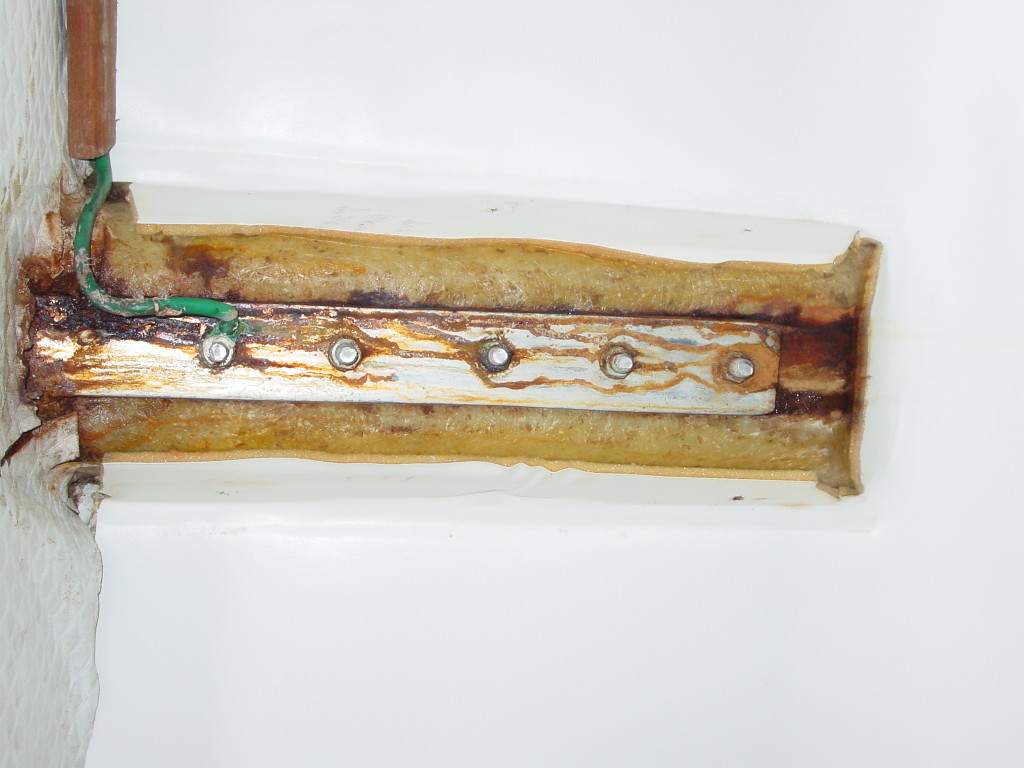
The biggest enemy of chainplates is corrosion. Although most chainplates are made of stainless steel, this does not mean they are immune from corrosion. The two most common types of corrosion that lead to failure are pit or crevice corrosion and stress corrosion. Stainless steel gains a good part of its corrosion resistance from a surface film that forms when the metal is exposed to oxygen. This causes a problem for chainplates that are installed through the deck though. The area where the chainplate passes through the deck is blocked from oxygen by sealants, trim plates and contact with the deck. Any moisture that gets into this area can, and will, cause corrosion. This problem is compounded with salt water. Small pits will form on the surface and begin to eat into the metal. To make matters worse this is an area that is not easily inspected. The movement of the deck and rig make this a tough area to seal and keep sealed. Additionally cycling loads placed on the chain plates can cause stress corrosion. Stress corrosion is a type of corrosion that results in hairline cracks that can lead to sudden catastrophic failure. Add to this the warm temperatures often found in warmer climates and the tropics and you have the perfect storm of corrosion for stainless steel.
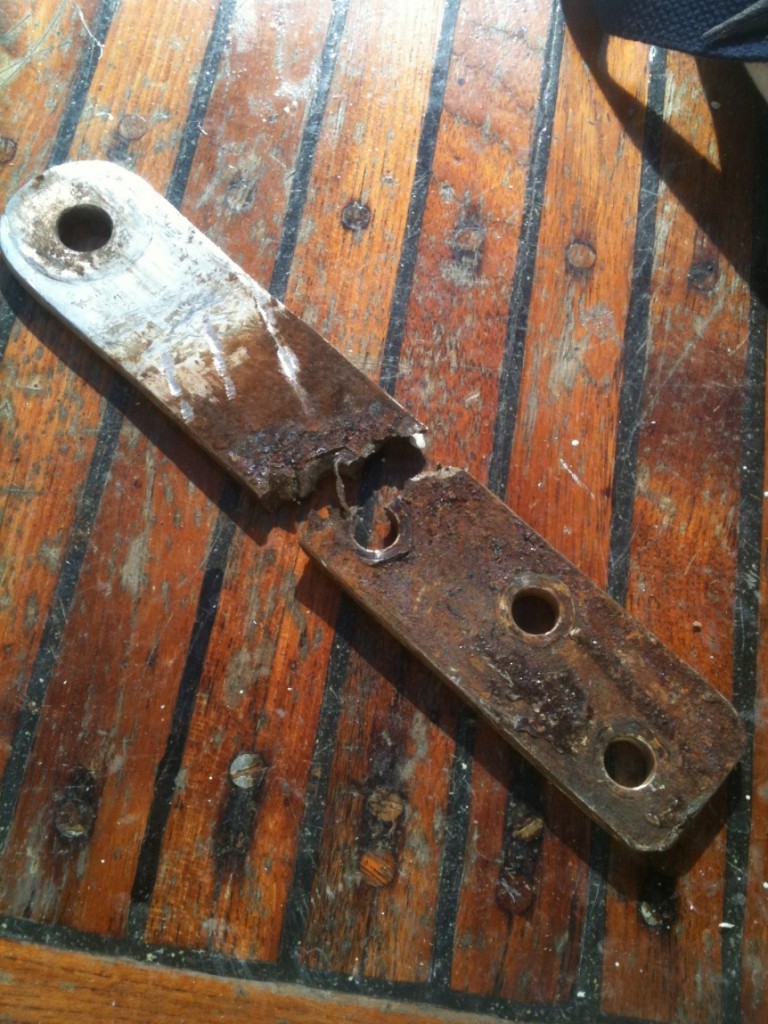
You might think at this point stainless steel would not be a good metal for chainplates. As with most things on boats, stainless steel is a compromise between strength and cost. There may be better metals out there but for the cost stainless is not a bad compromise. Knowing its weakness however is key to understanding its proper care. With proper care and a bit of attention to the problem areas stainless steel will give many years of good service.
I recommend most owners inspect their chainplates at least annually. I also recommend that the chainplates be, “pulled” or removed for a careful inspection once every 5 years after the boat is more than ten years old. Unfortunately not all boats are built in a way that makes chainplate inspection or replacement easy. Some builders seem to have gone out of their way to make this a difficult task while others have done just the opposite and make them easy to access. It is however important to look for signs of trouble no matter how the chainplates are installed.
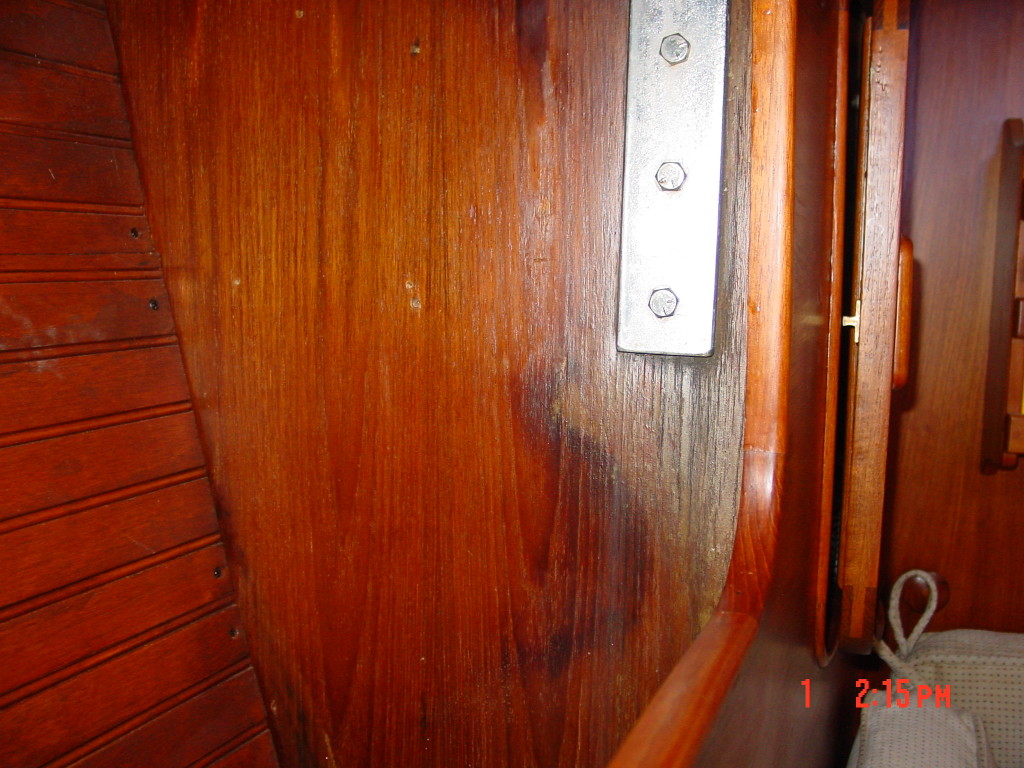
The most common chainplate is basically a flat bar that is bolted to an interior bulkhead or knee where it then passes through the deck with a metal trim plate fitted on the outside. Although this is the most common installation it is also one of the most prone to leaking. Movement of the deck and rigging will often cause the sealant around the chain plate to open up and let water in.
In another common installation the chainplates are welded to a horizontal plate that sits flush on the deck. The underside of this plate is then attached to a rod or bolt that passes through the deck to be attached to a structural member inside the boat. This type of assembly can be cast as one piece as well as welded. Lifting of the horizontal plate from the deck is a sign of problems and can lead to leaking. More often seem on smaller boats, U-bolts are sometimes used as well. All types of chain plates can suffer from pit or crevice corrosion where the fitting passes through the deck and often removal is the only way to really inspect for problems.
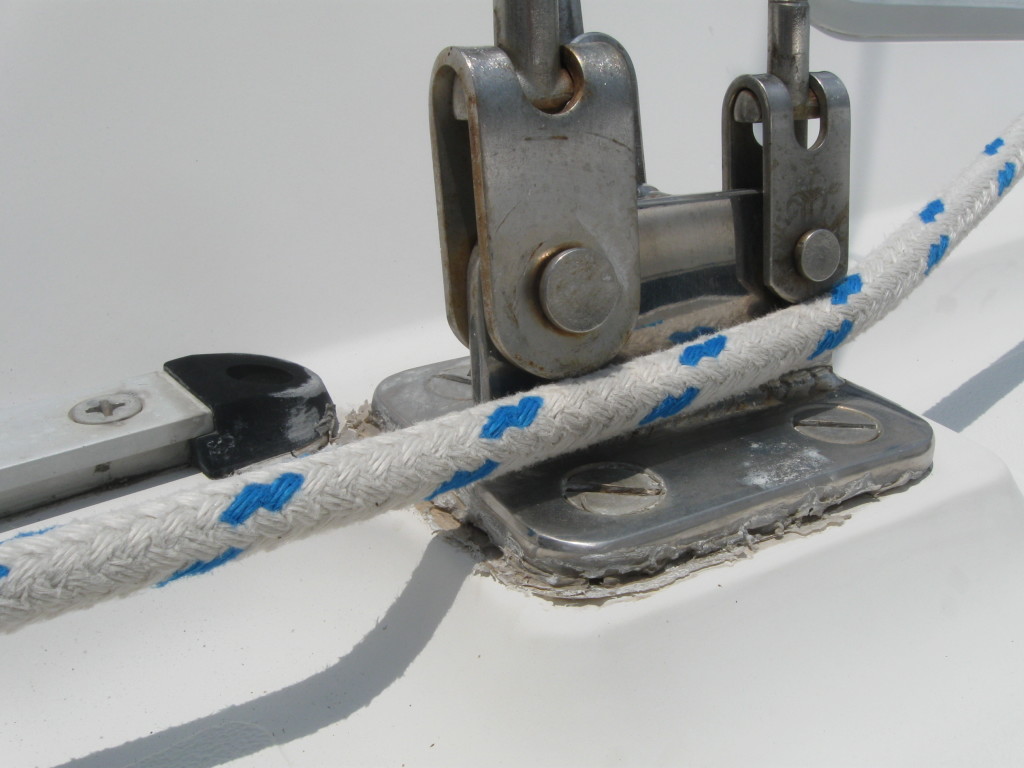
Most chainplates are bolted to a structural member inside the boat whoever some are glassed in. Chainplates that are glassed in are by far the worst to try to inspect or replace. To make matters worse the fiberglass can make corrosion issues worse. The fiberglass will trap any leaking moisture in around the metal. Fiberglass does not adhere well to metals and voids between the fiberglass and the chainplate are inevitable. If you have glassed in chainplates I strongly advise routine inspections for leaks on a frequent basis. It is also all but impossible to inspect the condition of the metal in these installations. The only real way to inspect glassed in chainplates is to completely remove the fiberglass, not an easy task and one that often requires dismantling joinery.
No matter how chainplates are installed the first place to start is with a visual inspection of the outside of the chainplates. Carefully inspect around clevis pin holes and bolt holes for cracks or any deformities. I like to use a magnifying glass to aid with this and will use a small piece of Scotch Brite pad to clean the metal where needed. Look carefully for hairline cracks or anything that does not look right. Look for rust stains particularly at holes and welds. Rust stains can be a tell tale sign of corrosion. Check any welds carefully for cracking along the weld. If you are inspecting chainplates bolted to the exterior of the hull check the bolts for rust staining as well. Check that any bolts holding the chainplates are flush and tight to the chainplate. Look for any signs of movement, pulling or lifting from the mounting surface.
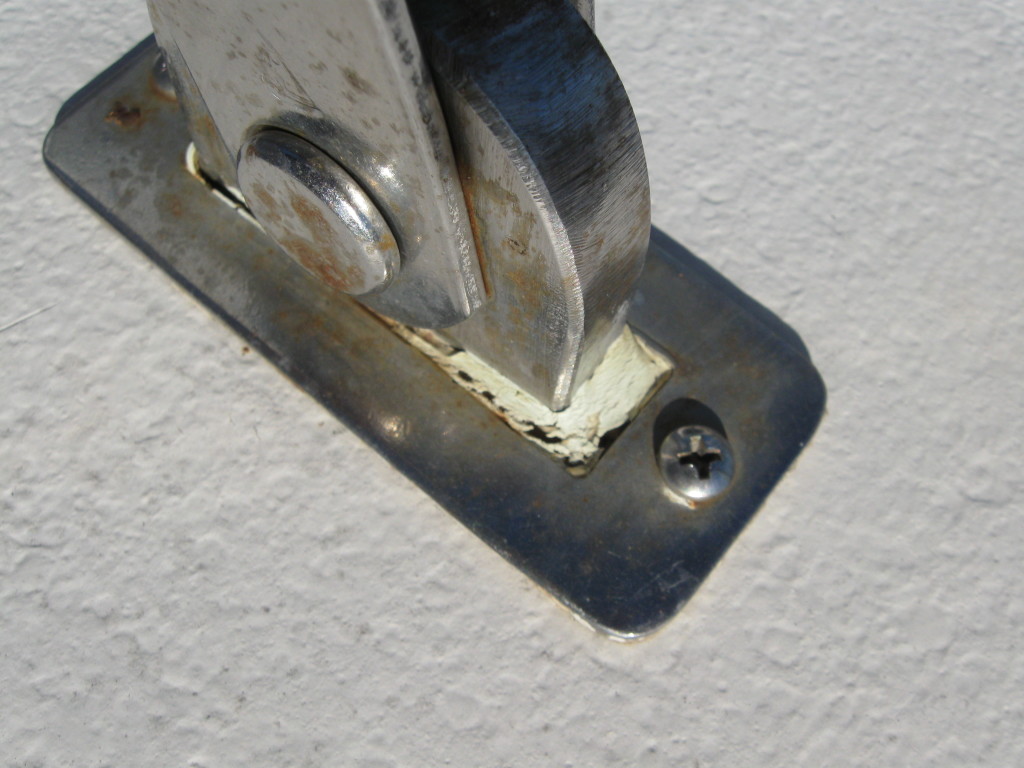
If the chainplate passes through the deck look carefully at the sealant around the opening. Check for any gaps or cracks in the sealant that could let water in. If any cracking or drying out of the sealant is noted it is time to renew all of the sealant. Before renewing sealant though, interior inspections should be done to see if the chainplate should be removed. If the sealant is bad on one chainplate but not others it would be best to plan to reseal all.
Next go inside the boat and try to access the underside of the chainplates. Remove any panels that you can to gain better access. If it is all but impossible to see the chainplates without major disassembly try looking down below where the chainplates are to see if there are any signs of water leaking or rust stains. Look at the wood work surrounding and below the chainplates as well for signs of water damage. Any signs of water or rust will require further investigation. Don’t forget to check the forestay and backstay chainplates as well. Forestays and backstays are often bolted onto the outside of the hull but you still need to look inside at the bolts and backup plates. Leaks on forestays and backstays are easy to overlook because they do not affect living spaces. As with the shroud chainplates, rust or water staining should be investigated
Some chainplates, particularly the horizontal plate type will have a stainless rod attached on the underside of the plate assemble. The lower end of this rod is then attached to a structural member on the hull. Sometimes there are toggles or turnbuckles fitted to the rod as well. Check that all bolts, nuts and other fittings are tight and secure. Any leaks under the plate at deck level will often run down the rod causing corrosion at the ends and fittings. The rods and particularly any fittings need to be carefully inspected for corrosion, cracking and other problems. Check the hull attachment members as well. If glassed in look for any signs of delamination or cracking in the fiber glass. A moisture meter can be helpful as well for checking structural members made of glass over wood as often seem in older boats.
If everything looks good and there are no signs of water leakage around the chainplates and you have not noticed any cracks, rust stains or other anomalies then you are likely good to go .If however, you saw any signs of problems it is time to get more serious. If you note any cracks in the metal or elongated holes it is time to start thinking about completely removing the chainplates for more careful inspection or replacement. If everything looks good but you are seeing signs of water leakage or rusting you may just need to reseal the chainplates, but before you can know for sure further investigation is required.
With the flat bar type of chain plate the trim plate can be removed and the sealant cleaned out to inspect the condition of the metal where it passes through the deck. This is an imperfect approach and this type of inspection is limited, however it may give you a chance to get a general feel for the condition of the metal. If any moisture or rust is noted it is time to pull the chainplate.
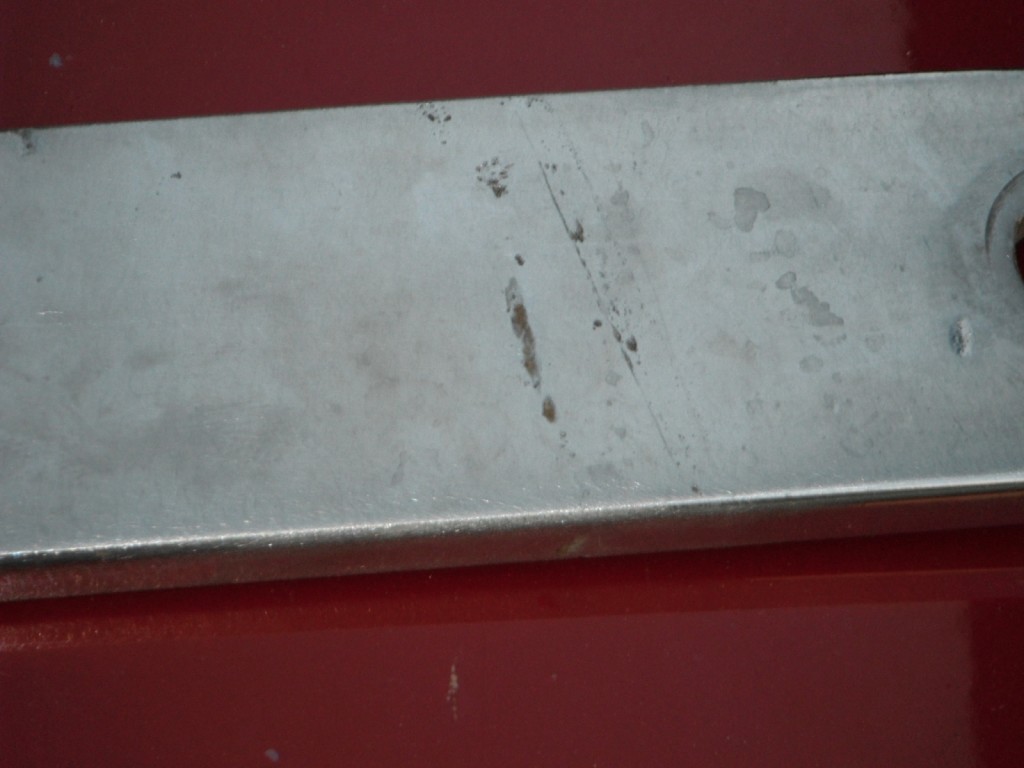
By far the most common failure point for chain plates is where it passes through the deck. This is true for most types of chainplates with the exception of forestay chainplates. Forestay chainplates will most often fail at a weld or where the metal is bent around the stem head. Forestay chainplates are also subject to damage from impacts with docks and such and are subject to side loading from the rig. Additionally any chainplate that passes through teak decking or cap rails should be carefully checked. The wood surrounding the chainplate will always contain some moisture and if there are any leaks the wood will hold the moisture longer so these are particularly susceptible to corrosion.
Although some chainplates can be very hard to remove it is often the only way to ensure they are in good condition. As mentioned earlier if your boat is older than ten years or you have seen any of the problem signs it may well be worth your effort to tackle this job. In many cases it is not as hard as it looks. For most boats this can be a weekend job. If access is poor you may be able to add removable panels to make the job easier. Worst case scenario as mentioned earlier is when the chain plates are glassed into the hull. Few builders do this but if you are unlucky enough to have glassed in chainplates pay close attention to the recommended inspections and consider an alternate system should you have to remove them.

Once the chainplates have been removed it is time to clean them up for inspection. Carefully remove all sealant that may be stuck to them. Solvent may help with this as well as some light scraping. Next use a medium Scotch Brite pad to polish any rust or stains from the surface. After cleaning visually inspect for any pitting or cracks. Again a magnifying glass will help with this. If you see any lines you are not sure about using a dye penetrate will aid in determining if it is a surface defect or crack. Check for surface pitting as well. Small pits will easily develop into deeper pits weakling the metal. If there is any doubt at all the chainplate should be replaced.
While you are at it you should carefully inspect the bolts securing the chainplates as well. Unless cost or availability is a factor it is best to just go ahead and replace the bolts. Check the bolt holes in both the chain plate and boat as well. If they are not a snug fit around the bolts it would be wise to drill the holes larger and install a larger bolt or bushing to remove any play.
If you end up removing your chainplates and they pass inspection o if you are replacing with new polishing will help. Few builders will fully polish their chainplates or even polish them at all. It would seem at first something you would do just to make them look good but it will extend their life as well. A polished surface on stainless helps protect it from pit corrosion. This is because pits do not start so readily on a very smooth surface. Polishing them for their full length and on all sides will help prevent corrosion as well as help you spot flaws and possible problems.
Some owners are replacing their stainless chainplates with titanium. This is a viable option if you are willing to spend the extra money. The cost is not just in the metal but also the machining as titanium is a harder metal and most machine shops will charge extra for working with this metal. Some shops will not even want to work with it in the first place. I have also heard of some owners switching to bronze but I am not in favor of this as it is a much softer metal. If bronze is to be used you will have to increase the size as well as makes sure you use a good grade. Bronze is also subject to pit corrosion so it will not completely solve the problem.
Composites are another option for chainplates. Careful engineering needs to be done with these and they do not lend themselves well for retro fitting an existing installation. I personally do not have a lot of experience with these so will reserve opinion other than to recommend a professional with experience be consulted before going this route.
It’s not like there were not enough chores on a boat, inspecting your chainplates is not high on the list of things to do.. The importance of regular inspections should be obvious though. Whether you cruise or race having the peace of mind knowing your chainplates are in good condition will allow you to relax and enjoy your time on the water. Annual chainplate inspections will provide you piece of mind and help protect you and boat from catastrophic damage.
If you found this helpful please like and share below to help educate others!
